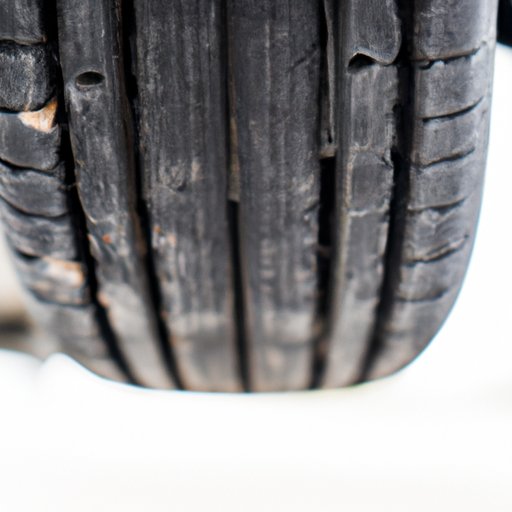
Introduction
Getting a flat tire is never fun, but it can be especially frustrating when it happens in the middle of a road trip or long drive. To make matters worse, replacing a flat tire with a temporary donut tire can leave drivers with more questions than answers. How long can you drive on a donut tire? What are the risks involved? Are there alternatives? In this article, we’ll explore everything you need to know about driving on a donut tire and provide tips for staying safe on the road.
Tips for Driving on a Donut Tire
One of the most important things to keep in mind when driving on a donut tire is that it’s not designed for long-term use. As such, it’s important to take certain precautions to avoid damaging the tire or putting yourself in danger.
First and foremost, it’s important to reduce your speed and avoid sharp turns to maintain control. Donut tires are smaller and narrower than regular tires, which can affect handling and steering. Be sure to adjust your driving accordingly.
Second, make sure to check the inflation of the tire regularly. A partially deflated donut tire can lead to further damage and create a hazardous situation on the road.
Finally, be prepared for decreased handling and braking distances. Donut tires are not designed for high performance or extended use, so it’s important to take things slow and be cautious when on the road.
How Long Can You Drive on a Donut Tire?
The lifespan of a donut tire can vary depending on a number of factors, including the weight of the vehicle and the distance traveled. However, as a general rule, most donut tires are designed to last around 50-70 miles. This short lifespan is due to the fact that donut tires are not equipped to handle extended use and can become damaged or compromised over time.
If you’re planning a longer trip or frequently drive long distances, it’s a good idea to keep a spare tire or alternative tire type on hand. This will allow you to safely continue your journey without worrying about the limitations of a donut tire.
Alternatives to Donut Tires
There are a few different options when it comes to emergency tires, each with its own set of pros and cons.
Full-size spares are a popular choice for many drivers, as they offer the same capabilities as a regular tire. However, they can be bulky and take up a significant amount of space in your vehicle. Additionally, full-size spares can be expensive and may not be included as standard equipment on all vehicles.
Run-flat technology is another option to consider. These tires are designed to continue functioning even after a puncture occurs, allowing drivers to continue on their journey without stopping to change a tire. However, run-flat tires can be expensive and often require special equipment to install and maintain.
Ultimately, the right choice will depend on your specific needs and circumstances.
The Dangers of Driving on a Donut Tire
While donut tires can be a lifesaver in an emergency, it’s important to remember that they are not intended for long-term use. Extended use of a donut tire can lead to a number of risks and hazards on the road.
One significant risk is reduced grip and handling. Donut tires are smaller and narrower than regular tires, which can affect stability and make it more difficult to navigate turns or stop quickly.
Additionally, driving on a donut tire can limit your mobility and decrease your options in an emergency. If you find yourself in a situation where you need to make a sudden turn or stop, a compromised donut tire may not be able to keep up.
Finally, driving on a donut tire for too long can increase the risk of blowouts or other failures. This can create a dangerous situation on the road and put you and your passengers at risk.
Maintaining Your Donut Tire
Proper care and maintenance of your donut tire can extend its lifespan and ensure it’s in good condition when you need it most.
First and foremost, it’s important to store your donut tire in a cool, dry place away from direct sunlight. This will help prevent cracking and other damage over time.
Additionally, be sure to inspect your donut tire regularly for signs of wear or damage. If you notice any cracks, bulges, or punctures, it’s time to replace the tire.
Finally, be sure to transport your spare tire safely and securely in your vehicle. A loose tire can become a dangerous projectile in the event of a collision or sudden stop.
Donut Tire vs Regular Tire
While donut tires can be a useful tool in an emergency, they do not offer the same performance benefits as regular tires.
Regular tires are designed to provide the best handling, stability, and distance coverage possible. They offer more grip and traction than donut tires, allowing drivers to navigate turns and stop quickly when needed.
Donut tires, on the other hand, are designed for short-term use and lower speeds. They are not designed for high performance or extended driving, which can lead to compromised grip and handling.
When considering which type of tire is right for your specific needs, it’s important to think about the driving situations you’ll be encountering most frequently.
Conclusion
Driving on a donut tire can be a bit nerve-wracking, but it’s important to stay calm and take the necessary precautions to stay safe on the road. Remember to reduce your speed and avoid sharp turns, check the inflation of your tire regularly, and plan for a short lifespan.
Ultimately, the best way to stay prepared for emergencies on the road is to keep a spare tire or alternative option on hand. By staying informed and aware of your options, you can ensure that you’re ready for anything the road might throw your way.





